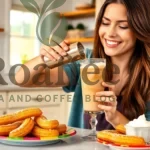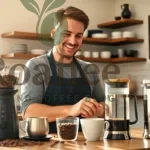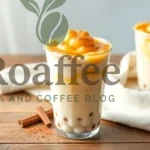We’ve all been there – standing in line at our favorite coffee shop wondering why we can’t recreate that perfect cup at home. The truth is you absolutely can make café-quality coffee in your own kitchen with the right techniques and a few simple tricks we’ve perfected over years of brewing.
Great coffee starts with understanding the fundamentals. From selecting the right beans to mastering your water temperature we’ll walk you through every step that separates mediocre coffee from exceptional brews. Whether you’re using a French press drip machine or pour-over setup the principles remain the same.
We’re about to share our foolproof method that transforms your morning routine into a barista-level experience. No expensive equipment required – just quality ingredients proper technique and attention to detail. Once you master these essentials you’ll never settle for subpar coffee again.
Equipment and Tools You’ll Need
Creating exceptional coffee at home starts with having the right tools at your disposal. We’ll break down the essential equipment you need versus nice-to-have additions that can elevate your brewing experience.
Essential Coffee Brewing Equipment
Coffee Maker or Brewing Device
We recommend starting with one of these reliable brewing methods:
- French Press – Perfect for beginners and delivers full-bodied coffee with minimal effort
- Pour-over dripper (V60, Chemex, or Kalita Wave) – Offers precise control over extraction
- Drip coffee maker – Convenient for daily use and consistent results
- Espresso machine – Essential for espresso-based drinks like lattes and cappuccinos
Coffee Grinder
Freshly ground beans make the biggest difference in coffee quality. We suggest these options:
- Burr grinder – Provides consistent particle size for optimal extraction
- Blade grinder – Budget-friendly option that works for most brewing methods
- Manual grinder – Portable and affordable with excellent grind consistency
Basic Measuring Tools
- Digital scale – Ensures accurate coffee-to-water ratios
- Measuring spoons – Alternative for consistent coffee portions
- Liquid measuring cup – Helps track water amounts
Water Equipment
- Kettle – Standard stovetop or electric kettle works perfectly
- Thermometer – Monitors water temperature for optimal extraction
- Filtered water source – Removes impurities that affect coffee taste
Optional Equipment for Enhanced Flavor
Precision Temperature Control
- Gooseneck kettle – Provides controlled water flow for pour-over brewing
- Electric kettle with temperature settings – Maintains precise water temperature automatically
- Immersion thermometer – Offers accurate temperature readings for consistency
Advanced Grinding Options
- High-end burr grinder – Delivers exceptional grind uniformity and multiple size settings
- Conical burr grinder – Reduces heat buildup during grinding process
Specialty Brewing Accessories
- Coffee filters – Paper filters for pour-over methods or permanent metal filters
- Tamper – Essential for espresso preparation and even coffee bed distribution
- Milk frother – Creates creamy foam for cappuccinos and lattes
- Coffee server or carafe – Keeps brewed coffee warm and ready to serve
- Airtight coffee storage container – Preserves bean freshness and prevents oxidation
- Coffee grinder cleaning tablets – Removes oils and residue buildup
- Descaling solution – Maintains machine performance and extends equipment life
Ingredients

Creating exceptional coffee at home requires just two primary ingredients: quality coffee beans and pure water. These foundational elements directly impact the flavor profile and overall quality of your brew.
Coffee Beans Selection
We recommend selecting fresh, high-quality coffee beans from reputable regions like Guatemala or Ethiopia for distinctive flavor profiles. These origins offer unique characteristics that elevate your home brewing experience.
Your taste preference should guide your roast selection:
- Light roast for bright, fruity notes
- Dark roast for richer, bolder flavors
Fresh grinding is essential for optimal taste. We suggest grinding beans just before brewing to preserve maximum flavor compounds. The grind size must match your brewing method for proper extraction:
| Brewing Method | Grind Size | Texture Reference |
|---|---|---|
| French Press | Coarse | Sea salt |
| Pour-over (large brewers like Chemex) | Medium-coarse | Kosher salt |
| Pour-over (small cones) | Fine | Table salt |
| Espresso | Fine | Powdered sugar |
Water Quality Requirements
Water comprises 98-99% of your coffee, making quality crucial for excellent results. We recommend using filtered water from systems like Brita or Berkey filters to eliminate chlorine and mineral off-flavors.
Temperature control is critical for proper extraction:
- Ideal range: 195°F to 205°F (90-96°C)
- Water below this range under-extracts flavor compounds
- Water above this range creates bitter, over-extracted coffee
Let freshly boiled water rest for 30 seconds before pouring over coffee grounds. Avoid re-boiling water as this alters oxygen levels and negatively impacts taste.
- Neutral pH around 7
- Moderate mineral content for enhanced extraction
- No chlorine or strong mineral flavors that overpower coffee notes
Prep
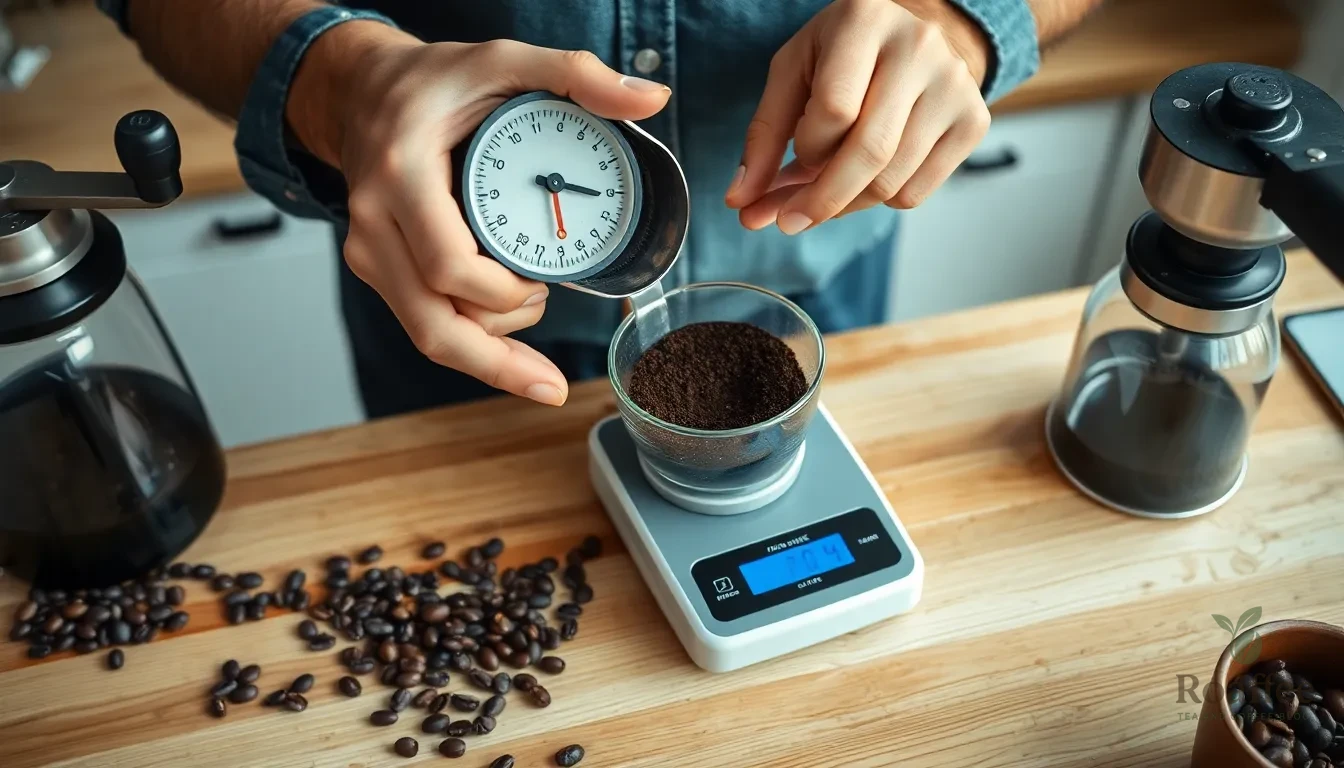
Proper preparation forms the foundation of exceptional coffee brewing. We need to focus on three critical elements that directly impact our final cup’s quality and flavor profile.
Choosing the Right Coffee Beans
We recommend selecting fresh, high-quality beans that match our taste preferences. Specialty coffee beans, particularly single-origin varieties, deliver the most distinctive and complex flavors. Purchasing whole beans preserves their essential oils and aromatic compounds that pre-ground coffee quickly loses.
Our bean selection should consider the roast level that complements our brewing method. Light roasts showcase origin characteristics and bright acidity, while dark roasts offer bold, smoky flavors. We suggest buying beans roasted within two weeks of our brewing date to ensure peak freshness and flavor development.
Grinding Your Coffee Beans
We must use a burr grinder for consistent particle size and optimal extraction. The grind size depends entirely on our chosen brewing method and requires exact attention to detail:
| Brewing Method | Grind Size | Texture Comparison |
|---|---|---|
| Espresso/Small Manual Pour-overs | Fine | Table salt |
| Large Pour-over Brewers (Chemex) | Medium-coarse | Kosher salt |
| French Press | Coarse | Sea salt |
Grinding immediately before brewing ensures maximum freshness and flavor retention. We should avoid grinding our beans until we’re ready to brew, as ground coffee loses its aromatics within minutes of grinding.
Measuring Coffee and Water Ratios
We need precise measurements for consistent results every time. The ideal coffee-to-water ratio is approximately 1:18, meaning 1 gram of coffee for every 18 grams of water. Using a kitchen scale provides the accuracy necessary for repeatable brewing success.
For practical application, brewing 10 ounces (283 grams) of coffee at a 1:17 ratio requires exactly 16.5 grams of coffee. We recommend starting with these ratios and adjusting based on our taste preferences. Stronger coffee requires a higher coffee-to-water ratio, while milder coffee needs less coffee relative to water.
Instructions
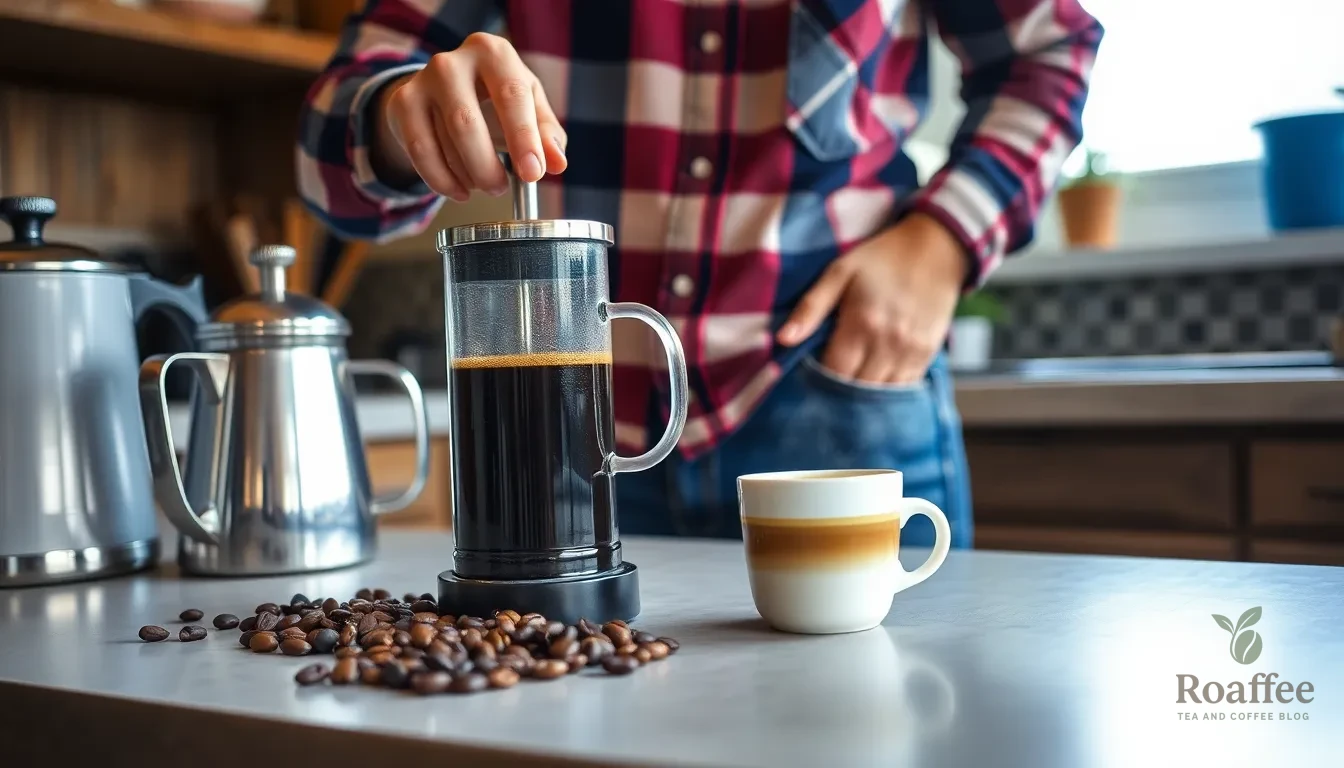
Now that we’ve prepared our beans and measured our ratios, let’s walk through the step-by-step brewing process for each method. We’ll start with the most forgiving technique and progress to more advanced methods.
French Press Method
Step 1: Heat water to 200°F and coarse grind your coffee beans to a sea salt texture.
Step 2: Add ground coffee to the French press using a 1:15 ratio (approximately 30g coffee to 450g water).
Step 3: Pour hot water over the grounds, filling the press halfway first to allow the coffee to bloom for 30 seconds.
Step 4: Add remaining water and stir gently to ensure all grounds are saturated.
Step 5: Place the lid on the press with the plunger pulled up and let the coffee steep for 4-5 minutes.
Step 6: Press the plunger down slowly with steady pressure to separate the grounds from the brew.
Step 7: Serve immediately to prevent over-extraction and enjoy the full-bodied, strong coffee with enhanced oils and sediment.
Pour Over Method
Step 1: Heat water to 195°F-205°F and grind coffee to a medium-fine consistency similar to table salt.
Step 2: Place a paper filter in your cone-shaped dripper and rinse it with hot water to eliminate paper taste.
Step 3: Add 22g of ground coffee to the filter and create a small well in the center.
Step 4: Start your timer and pour twice the weight of water as coffee (44g) in a circular motion for the bloom phase.
Step 5: Wait 30 seconds for the coffee to degas and expand.
Step 6: Continue pouring in slow, circular motions, adding water in 50g increments every 30 seconds.
Step 7: Maintain total brew time between 4-6 minutes for optimal extraction.
Step 8: Remove the dripper once dripping stops and enjoy the clean, bright cup with nuanced flavor notes.
Drip Coffee Maker Method
Step 1: Fill the water reservoir with filtered water according to your desired coffee strength.
Step 2: Insert a paper filter into the basket and add medium ground coffee using a 1:18 ratio.
Step 3: Ensure the coffee bed is level for even water distribution during brewing.
Step 4: Start the machine and allow the automated brewing cycle to complete.
Step 5: The hot water will drip through the coffee grounds automatically, maintaining consistent temperature throughout the process.
Step 6: Wait for the full brewing cycle to finish before removing the carafe.
Step 7: Serve the balanced, mild coffee immediately for best flavor.
Espresso Machine Method
Step 1: Heat your espresso machine and ensure the portafilter is clean and warm.
Step 2: Grind coffee beans to a fine consistency similar to powdered sugar.
Step 3: Dose 18-20g of ground coffee into the portafilter basket.
Step 4: Level the grounds and tamp with 30 pounds of pressure to create an even surface.
Step 5: Lock the portafilter into the machine and place your cup underneath.
Step 6: Start extraction immediately and aim for a 25-30 second pull time.
Step 7: Stop extraction when you’ve pulled 36-40ml of espresso with a rich crema on top.
Step 8: Serve immediately or use as a base for lattes and cappuccinos to enjoy the most concentrated and intense coffee flavor.
Directions for Perfect Brewing
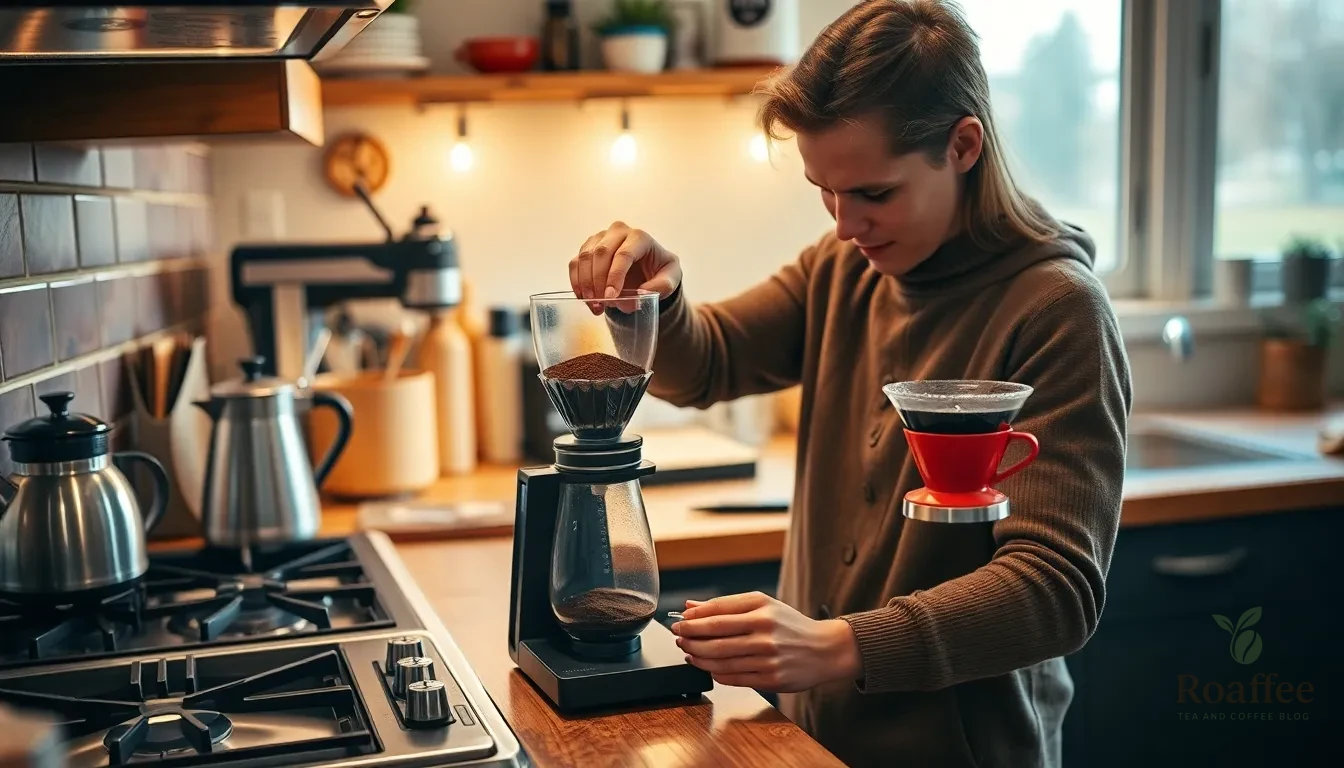
Now that we’ve covered the essential preparation steps, let’s jump into the key brewing techniques that will transform your coffee from ordinary to extraordinary. These three fundamental elements will ensure consistent, flavorful results every time you brew.
Water Temperature Guidelines
Water temperature plays a crucial role in extracting the perfect balance of flavors from your coffee grounds. We recommend maintaining water between 195°F to 205°F (90°C to 96°C) for optimal extraction results.
| Temperature Range | Extraction Result |
|---|---|
| Below 195°F (90°C) | Under-extraction, weak coffee |
| 195°F to 205°F (90°C to 96°C) | Optimal extraction, balanced flavor |
| Above 205°F (96°C) | Over-extraction, bitter compounds |
When water exceeds 205°F, it extracts bitter compounds that overwhelm the coffee’s natural flavors. Conversely, water cooler than 195°F results in under-extraction, producing weak and sour coffee.
If you don’t have a thermometer, bring water to a rolling boil and let it rest for 20 seconds before brewing. This simple technique consistently achieves the ideal temperature range for most brewing methods.
Timing Your Brew
Brewing time directly impacts flavor extraction and strength. Each brewing method requires exact timing to achieve optimal results without over-extraction.
| Brewing Method | Recommended Time |
|---|---|
| Pour-over | 2-3 minutes |
| French press | 4-5 minutes |
| Espresso | 25-30 seconds |
| Cold brew | 12-24 hours |
We recommend avoiding brewing longer than 8 minutes for hot brewing methods to prevent over-extraction and bitterness. French press requires 4-5 minutes of immersion time, while pour-over typically takes 2-3 minutes for complete extraction.
Timing consistency ensures reproducible results. Use a timer for each brewing session to maintain the same extraction time and develop your taste preferences.
Proper Extraction Techniques
Understanding how water interacts with coffee grounds allows us to control extraction and achieve balanced flavor profiles. Different brewing methods use distinct extraction approaches to highlight various coffee characteristics.
Pour-over methods give us complete control over flow rate and saturation patterns. We can regulate how water contacts the grounds, ensuring even extraction and balanced flavor development.
Immersion methods like French press allow grounds to steep in water for extended periods. This longer contact time produces bolder, fuller-bodied flavors due to complete saturation and extraction.
Pressure-based methods such as espresso use high pressure for quick, intense extraction. This technique creates concentrated coffee with rich crema and complex flavor layers.
We can fine-tune our coffee’s flavor and strength by adjusting three key variables: grind size, water temperature, and brewing time. Coarser grinds require longer brewing times, while finer grinds extract more quickly. This relationship between grind size and extraction time helps us achieve the perfect balance for our preferred taste profile.
Make-Ahead Tips

We can significantly improve our coffee routine by implementing smart preparation strategies that save time while maintaining quality. These techniques ensure we always have access to fresh coffee and convenient brewing options.
Storing Coffee Beans
We must prioritize proper storage to preserve the freshness and flavor of our coffee beans. Fresh coffee beans should remain whole and stored in an airtight container away from light, moisture, and heat to maintain their optimal taste profile.
Our storage strategy should focus on protecting beans from the four main enemies of coffee freshness: air, light, heat, and moisture. We recommend using opaque, airtight containers made of ceramic or glass rather than clear containers that expose beans to light degradation.
We should avoid storing coffee in the refrigerator or freezer, as temperature fluctuations create condensation that damages the beans’ cellular structure. Instead, we place our storage containers in a cool, dry pantry or cupboard away from heat sources like stoves or direct sunlight.
The grinding process should occur immediately before brewing for maximum flavor retention. We maintain this practice because ground coffee loses its aromatic compounds rapidly when exposed to air, resulting in stale and flat-tasting coffee within hours of grinding.
Preparing Cold Brew Concentrate
We can prepare cold brew concentrate in advance for a convenient and smooth coffee option that stays fresh for several days. This method involves steeping coarsely ground coffee in cold, filtered water for 12-24 hours to extract flavors without heat.
Our recommended ratio follows a 1:4 proportion, using 1 cup of coffee to 4 cups of water for optimal strength and flavor balance. We use a coarse grind similar to sea salt texture to prevent over-extraction and minimize sediment in the final concentrate.
We combine the coffee and water in a large jar or French press, stirring gently to ensure all grounds are saturated. The mixture should steep in the refrigerator for 12-24 hours, allowing the extended contact time to extract the coffee’s natural sugars and oils while reducing acidity.
After steeping, we strain the mixture through a fine-mesh strainer or cheesecloth to remove all coffee grounds. The resulting concentrate can be stored in the refrigerator for up to two weeks, providing us with a ready-to-use base for iced coffee drinks.
We can serve the concentrate over ice diluted with water or milk, or use it as a base for coffee cocktails and desserts. This preparation method delivers smooth, less acidic coffee that appeals to those who find hot-brewed coffee too harsh or bitter.
Troubleshooting Common Coffee Problems
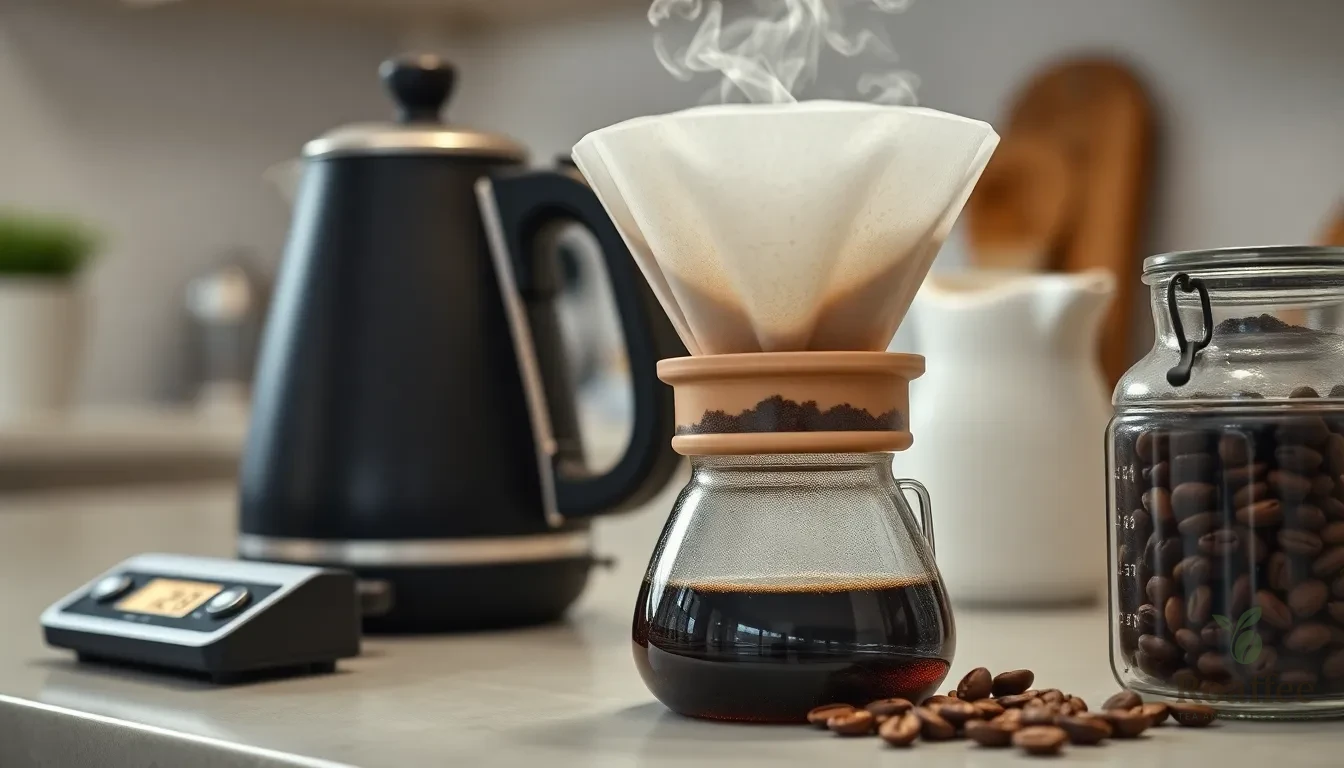
Even with the best preparation techniques we’ve covered, coffee brewing can sometimes produce unexpected results. We’ll address the most common issues that home brewers encounter and provide research-based answers to perfect your cup.
Fixing Bitter Coffee
Bitter coffee typically results from over-extraction, which occurs when brewing variables push beyond optimal ranges. We often see this problem when grounds are too fine, brewing time extends too long, or water temperature runs too hot.
Adjust your grind size by making it coarser to reduce extraction rate. For pour-over methods, move from a fine grind to medium-fine consistency. French press users should ensure grounds resemble coarse sea salt rather than table salt.
Shorten brewing time according to your method’s specifications. Espresso shots should extract in 25-30 seconds, while French press steeping should not exceed 4-5 minutes. Pour-over brewing should complete within 3-4 minutes total.
Check water temperature to ensure it stays within the 195-205°F range we discussed earlier. Water that’s too hot will extract bitter compounds from the coffee grounds more aggressively.
Verify bean freshness since stale beans develop harsh, bitter flavors over time. Store your beans in airtight containers and grind just before brewing for optimal taste.
Clean your equipment regularly to prevent oil buildup that contributes to off-flavors and bitterness. Old coffee oils turn rancid and negatively impact your fresh brew.
Addressing Weak or Sour Coffee
Weak or sour coffee indicates under-extraction, where not enough flavor compounds have been pulled from the grounds. This problem stems from grind size being too coarse, brewing time being too short, or insufficient coffee-to-water ratio.
Use a finer grind to increase the surface area available for extraction. Move from medium-coarse to medium grind for drip methods, or from coarse to medium-coarse for French press brewing.
Extend brewing time within reasonable limits for your chosen method. Allow pour-over brewing to reach 4-5 minutes if currently finishing in 2-3 minutes. French press can steep up to 5 minutes for fuller extraction.
Adjust coffee-to-water ratio by increasing the amount of coffee grounds. Move from a 1:18 ratio to 1:15 or 1:16 for stronger extraction. Add an extra tablespoon of grounds per 6 ounces of water as a starting point.
Verify water temperature reaches the optimal 195-205°F range. Water that’s too cool won’t extract enough flavor compounds from the grounds.
Check bean quality and roast level since under-roasted beans can produce sour notes. Light roasts naturally have more acidity, so consider medium roasts if sourness persists even though proper brewing adjustments.
Conclusion
We’ve armed you with everything you need to transform your daily coffee ritual into a barista-quality experience. From selecting premium beans to mastering brewing techniques these fundamentals will elevate every cup you make.
Remember that great coffee isn’t about expensive equipment—it’s about understanding the science behind extraction and applying these proven methods consistently. Whether you prefer the boldness of French press or the precision of pour-over you now have the knowledge to achieve café-quality results.
The journey to perfect coffee is personal and we encourage you to experiment with different variables until you discover your ideal flavor profile. With proper preparation troubleshooting skills and these time-tested techniques you’ll never need to settle for mediocre coffee again.
Start brewing today and taste the difference that knowledge and quality ingredients can make in your morning routine.
Frequently Asked Questions
What equipment do I need to make café-quality coffee at home?
You need a reliable brewing method (French Press, pour-over, or drip coffee maker), a quality coffee grinder (burr grinder preferred), measuring tools like a digital scale, and a kettle with thermometer for water temperature control. Optional additions include precision temperature tools, specialty filters, and milk frothers for enhanced flavor and café-style drinks.
How do I choose the right coffee beans for home brewing?
Select fresh, high-quality specialty coffee beans, preferably single-origin varieties from reputable regions like Guatemala or Ethiopia. Purchase whole beans rather than pre-ground to maintain optimal flavor retention. Choose roast levels based on your taste preferences – light roasts for bright, acidic notes or dark roasts for bold, robust flavors.
What’s the ideal coffee-to-water ratio for brewing?
The recommended coffee-to-water ratio is approximately 1:18 for consistent results. This means using about 1 gram of coffee for every 18 grams of water. You can adjust this ratio based on personal taste preferences – use more coffee for stronger brew or less for milder flavor.
What water temperature should I use for brewing coffee?
Use water heated to 195°F to 205°F (90°C to 96°C) for optimal extraction. Water that’s too hot can over-extract and create bitter flavors, while water that’s too cool will under-extract and produce weak, sour coffee. A thermometer helps ensure consistent temperature control.
How long should I brew coffee using different methods?
Brewing times vary by method: French Press requires 4-5 minutes, pour-over takes 3-4 minutes, drip coffee makers run 5-6 minutes, and espresso extracts in 25-30 seconds. Following these timeframes helps prevent over-extraction (bitter taste) or under-extraction (weak, sour flavor).
Why does my coffee taste bitter and how can I fix it?
Bitter coffee typically results from over-extraction due to fine grind size, excessive brewing time, or high water temperature. Fix this by using a coarser grind, reducing brewing time, lowering water temperature, or adjusting your coffee-to-water ratio. Also ensure your beans are fresh and equipment is clean.
How should I store coffee beans to maintain freshness?
Store coffee beans in airtight containers away from light, moisture, and heat. Keep them at room temperature – avoid refrigerator or freezer storage as temperature fluctuations can damage the beans. Properly stored beans maintain optimal flavor for 2-4 weeks after roasting.
Can I prepare coffee in advance without losing quality?
Yes, you can prepare cold brew concentrate in advance by steeping coarsely ground coffee in cold, filtered water for 12-24 hours. This concentrate can be stored for up to two weeks and provides a convenient base for iced coffee drinks while maintaining smooth flavor.














